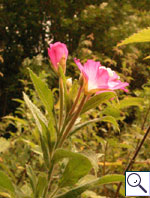|
||||||
|
EPILOBIUM. Willowherbs. [Onagraceae] |
|
|
Sixteen species of Epilobium are recorded in Britain, ten of which are native including Broad-leaved Willowherb (E. montanum) and Great Willowherb (E. hirsutum). The BSBI provide a downloadable plant crib for Epilobium. Eight British miners are recorded on Epilobium. A key to the European miners recorded on Epilobium is provided in Bladmineerders van Europa. |
|
Key for the identification of the known mines of British |
1a > Leaf and bark mine: Mining the stems and later the leaves. The larva lives as a bark miner in late summer and autumn. It descends into the rootstock for hibernation. After hibernation large, lower surface blotch mines are made in the lower leaves, from a gallery in the bark. They start in the base of the leaf, and are centered over the midrib. The mine contains hardly any frass. The larva can make several mines. Sometimes several larvae in a mine. Pupation in the mine. |
|
Mompha ochraceella (Curtis, 1839) [Lepidoptera: Momphidae]. |
1b > Leaf-miner: A distinctive mine primarily above mid-rib, with irregular short lateral offshoots into leaf blade. Pupation external (Spencer, 1972: 51 (fig. 172), 55; Spencer, 1976: 270, 271 (fig. 486)). Branched, whitish, upper-surface corridor; main axis overlying the midrib; side branches overlying the main lateral veins. (In Campanula and Phyteuma the mine is much less branched, sometimes nothing more than a corridor on top of the midrib). Frass in rather long strings. Usually the mines begins as a long and narrow, shallow, tortuous lower-surface corridor that ends upon the midrib but otherwise is not associated with the leaf venation. Often this initial corridor is filled with callus, and then even less conspicuous. Pupation outside the mine. A linear mine on the upper surface, usually following the midrib and showing side branches along the veins. The frass is in strings. |
|
Liriomyza strigata (Meigen, 1830) [Diptera: Agromyzidae]. |
1c > Leaf-miner: In the first instar the larva mines the leaves, forming short, irregular, blotch-like mines, but in later instars it lives externally, feeding in spun leaves and often twisting those of tender shoots. Larval head light-brown or yellowish brown, edged with black postero-laterally, ocellar area blackish; prothoracic plate black edged with whitish anteriorly; abdomen dull dark green; pinacula distinct, black, sometimes brownish but with black bases to setae; anal plate large, black (Bradley et al., 1973). Small, full depth mine without a definite shape; little frass. Some silk is deposited in the mine. The larva soon leaves the mine and continues feeding among spun leaves. |
|
Cnephasia incertana (Treitschke, 1835) [Lepidoptera: Tortricidae]. |
1d > Leaf-miner: The larvae feed mainly on Broad-leaved Willowherb mining the leaves. Large full depth blotch in the lower leaves. Much frass in coarse grains. The larva easily leaves its mine and restart elsewhere. Pupation either in the mine or in the ground. Mines cannot be told apart from those of Mompha propinquella. |
|
Mompha lacteella (Stephens, 1834) [Lepidoptera: Momphidae]. |
1e > Leaf-miner: A narrow contorted gallery leading to a whitish blotch with scattered frass centrally. The early gallery can merge with the blotch and there are often several to a leaf. The larva begins by making a full depth corridor, erratic in width and course; frass black, in an irregular central line. Later the larva makes a blotch, with frass in irregular clouds. This blotch can be a continuation of the corridor, but may just as well be on a different leaf. Often several mines in a leaf; in such cases the entire leaf me be mined out. Mines white at first, turning brown later. The larva lies venter-upwards in the mine. Pupation external. |
|
Mompha langiella (Hübner, 1796) [Lepidoptera: Momphidae]. |
1f > Leaf-miner: The mine is a whitish blotch with scattered blackish frass (UKMoths), usually low on the plant. Oviposition on the basal part of the midrib. The young larva makes a number of short corridors radiating from this point, either in the same leaf, or on different ones; they have a central frassline, but their final sections are free of frass. Later an elongate blotch is make, also beginning on the midrib (although not necessarily its basal part). Pupation external. Pupation in a white cocoon, which is attached to vegetation or leaf litter. |
|
Mompha locupletella (Denis & Schiffermüller, 1775) [Lepidoptera: Momphidae]. |
1g > Leaf-miner: Large full depth blotch in the lower leaves; much frass in coarse grains. The larva can make several mines. Pupation either in the mine or in the ground. Mines cannot be distinguished from those of Mompha lacteella. |
|
Mompha propinquella (Stainton, 1851) [Lepidoptera: Momphidae]. |
1h > Leaf-miner: Early mines are spiral galleries; later forms pale blotches, sometimes having moved to a different leaf. Egg at the upperside of the leaf, not near the midrib. The larva starts by making a long, narrow, full depth corridor that is strongly spiraled or even lies in intestine-like loops. Frass as fine grains, distributed, later in a central line. After a while a new mine is made, either a continuation of the corridor or, more often, in a new leaf. This new mine begins as a narrow corridor but soon widens into a large blotch; here the fass lies in a broad band. The larva lies venter-upwards in the mine. Pupation external. |
|
Mompha terminella (Humphreys & Westwood, 1845) [Lepidoptera: Momphidae]. |
| Last updated 04-Jul-2019 Brian Pitkin | ||

